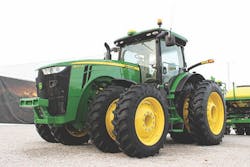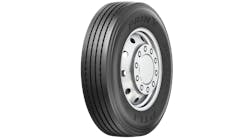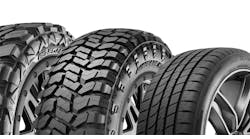Modern Tire Dealer has partnered with AG Tire Talk to provide answers to the insightful questions farm tire dealers have about farm tire technology. This is the second in a series, which is designed to help agricultural tire dealers better connect with their customers.
A trending question followed by an abridged version of the answers will appear in our Commercial Tire Dealer section every other month; for the complete answers, check out www.agtiretalk.com!
Question: In MFWD (mechanical front-wheel drive) tractor row crop applications, what tire features should the grower look for to improve traction, reduce operator fatigue and improve yield?
James Crouch, marketing specialist, Alliance Tire Americas Inc.: One of the most effective ways to improve traction, protect yields and reduce operator fatigue is to operate at the lowest appropriate inflation pressure. Reduced pressure creates a larger footprint, which increases traction in all conditions.
That larger footprint also increases flotation. By increasing flotation, you can reduce rolling resistance and minimize soil compaction. Reduced compaction has been shown to improve yields by preserving the soil’s natural structure, which contains spaces where air and water can be accessed by growing roots.
The reduced pressure in the tire also allows the sidewall to act as shock absorbers between the operator and the field, reducing jolt and vibration and providing a smoother ride that reduces operator fatigue.
Reducing inflation pressure can be accomplished with any tire — just check the manufacturer’s load/inflation table for your tire at the weight and speed you’ll be working with. New technologies such as IF (increased flexion) and VF (very high flexion) tires really amplify the effect because their design and construction allow them to operate at especially low inflation pressures, and their extra-flexible sidewalls provide an extremely smooth ride.
Scott Sloan, ag product manager/global LSW, Titan International Inc.: For decades the vast majority of the tires leaving the factory on MFWD were typically stand row crop duals, meaning typical width of the tires are about 18 inches. The concept is that the tires will run in the row and straddle the planted seed bed. Technologies in those sizes have evolved to IF/VF. This is a deflection technology in which tire manufacturers are allowing end users to operate at lower inflation pressures — 20% with IF and 40% with VF. As the tire deflects more, the footprint grows and increases the contact area of the tire, reducing the ground bearing pressure and, in turn, reducing compaction.
The major downside is that this technology is 100% based on the fact that end users have to constantly maintain and adjust inflation pressures according to the application or implements they are transporting and using in the field. The one time inflation pressures are not adjusted, that end user just lost the advantage he paid for getting into IF/VF technology tires.Titan, along with most major tire manufacturers, have IF/VF technology, but we prefer to live in the real world knowing that end users have an extremely difficult time managing inflation pressures — if they do at all.
Titan has introduced what I call a dummy proof bolt on technology with our LSW Extreme Floatation super single line. These LSW (Low Sidewall) tires not only incorporate LSW technology which reduces power hop and road lope that improves operator comfort and fuel economy, these tires due to their physical size are designed to replace standard row crop duals providing up to a 25% larger footprint under the tractor.
Norberto Herbener, OE applications engineer, Trelleborg Wheel Systems Americas Inc.: Every farmer strives to use 100% of horsepower available to them. There are several aspects a farmer must consider when selecting tires for his equipment. The selection will depend on the objective — for example traction, compaction, ride comfort, etc. — and also take into consideration restrictions such as max size that can be used, local weight and width restrictions, farm space, etc.
Once the size has been selected, the producer must decide which technology and design to choose. First, take into consideration the tread pattern type. For tractors, most commonly used are the R-1 or R-1W types. R-1W is an evolution of R-1, where the W means “Wet.” A notable difference is that on the same tire size, the height of a lug on an R-1W is 20% taller compared to an R-1.
Also, the profile of an R-1W is squarer in shape than an R-1 tread design. Advantages of an R-1W design are better traction due to lugs going deeper in the soil; more lug contact with the ground, which allows better traction and less compaction; and... longer durability, as the tire has 20% more rubber on its shoulder.
The second point is the lug pattern design. With a 45-degree design, the tire offers more lug area in contact with the ground all times.
In addition, the 45-degree lugs improve ride comfort. A 45-degree lug design is considered a midpoint between a bumpy ride in a metal track design, which would be lugs at a 90-degree angle with the ground, and a rib tire, where the ribs are parallel with the direction of travel.
The next point is the lug design and geometry. After years of testing and experience, current lug designs have adapted to be curved to ensure better traction and self-cleaning capabilities. The most advance tire designs, like Trelleborg’s TM series, include lugs with various widths, “wings” on the end of the lug that help to maximize the tread width for an extra wide footprint resulting in lower compaction, and a wider lug head to improve wear resistance and longevity.
David Graden: ag sales and development manager, Michelin North America Inc.: In a MFWD Row Crop application, there are many things that can be done to improve traction, reduce operator fatigue and, especially, improve yield. For instance, you need a tire that can carry the maximum operating weight at low air pressures in addition to providing a long, wide, flat footprint as a result of flexible sidewalls.
One of the simplest (and) most cost effective is to fit your tractor with VF tires.
With the help of your Michelin Ag Rep, you will have the ability to weigh your machine, calculate the proper weight distribution to transfer maximum torque, and dial in your air pressures to the lowest possible inflation to carry the maximum load.
With proper weight distribution and air pressures in a VF tire, you will gain an incredible foot print that not only carries your load smoothly across road and field, but will provide you with substantial traction and yield gains due to less compaction! Recently, Harper Adams University... conducted an independent study showing yield gains of up to +4% and fuel consumption of -10% while using Michelin VF tires versus standard tires.
Bradley Harris, manager of global agricultural field engineering, Firestone Ag Division, Bridgestone Americas Tire Operations LLC: When operators start looking at tire options, there are multiple questions asked by the tire dealer.
- Tire construction: radial or bias? When purchasing tires for a MFWD tractor used for primary tillage or planting, radial tires are more efficient then the same sized bias tire. When properly inflated, radial tires develop a longer footprint compared to the bias tire and carry the same axle load at less inflation pressure. The longer footprint allows for more tread bars to make contact with the soil, and it develops more traction. More traction results in less slip and that allows for more work to be completed in the short planting and harvesting window. The longer footprint of the radial tire also results in a longer wear life compared to the bias tire.
- Tread Depth: R-1, R-1W, R-2? Tires marked R-1W have a tread depth that is 20 to 30% deeper than the same sized R-1 tire. The tread depth of R-2 tires is two times deeper than R-1 tires. In most North American soils, R-1 and R-1W tires are the standard tread depth used. When working in wet soils found in the Mississippi Delta, in any bayou region, or muck soils an R-2 tread depth tire is recommended.
- Standard radials: IF radials or VF radials? Radial tires marked IF carry 20% more load compared to standard radial, and VF tires carry 40% more load. The IF tires and VF tires, when inflated properly to carry the axle load, do provide a longer footprint compared to the standard radial tire, which does improve traction. On MFWD tractors, operators who see the greatest benefit are the ones who are carrying heavy axle loads and using inflation pressures above 25 psi.
While tires are a major contributor to efficiency, operators must first make sure the MFWD tractor is ballasted correctly with the proper weight split. If the tractor is set up incorrectly, the benefits outlined will not be realized by the operator.
Dave Paulk, manager of field technical services, BKT USA Inc.: When selecting a tire for MFWD Row Crop tractors, there are several factors that should be considered to improve traction, improve yield and reduce operator fatigue.
Tires with the correct load-carrying capacity for the tractor and implements should be used. Correct air pressures help eliminate tire issues from overloading and rider comfort. The lower the air pressure a farmer can use, the softer the ride.
Proper traction is important to minimize fuel costs, save operator time in the field and avoid slippage on the tires. BKT’s radial agricultural tires are designed as R-1W’s with a 45-degree lug. The R-1W has 20% deeper tread than a comparable R-1. The 45-degree lug provides excellent traction in the field. These tires have excellent self-cleaning features that prevent mud and dirt buildup in the lugs.
The IF-rated tire is designed to carry 20% more load at the same air pressure as a standard tire. With this in mind, you can run these tires at lower air pressures to carry the same weight as your standard tire.
Eliminating power hop is important for driver comfort on an MFWD tractor. This can be achieved by ensuring that the tractor is weighted correctly with the proper air pressure. ?
James Tuschner has spent more than 20 years in the tire industry, primarily focused on the agricultural and specialty tire markets. His experience includes time spent at Alliance Tire Americas Inc. (first as director of marketing, then as director of business development). He started www.agtiretalk.com in 2016.



